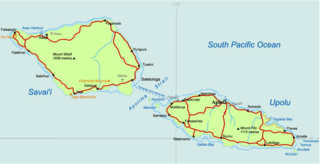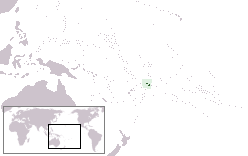Upolu
Upolu is an island in Samoa, formed by a massive basaltic shield volcano which rises from the seafloor of the western Pacific Ocean. The island is 75 kilometres (47 miles) long and 1,125 square kilometres (434 square miles) in area, making it the second largest of the Samoan Islands geographically. With approximately 145,000 people, it is by far the most populated of the Samoan Islands. Upolu is situated to the southeast of Savai'i, the "big island". Apia, the capital, is in the middle of the north coast, with Faleolo International Airport at the western end of the island. The island has not had any historically recorded eruptions, although three lava flows date back only a few hundred to a few thousand years.
 Map of Samoa showing Upolu at right | |
 | |
| Geography | |
|---|---|
| Location | Pacific Ocean |
| Coordinates | 13°55′S 171°45′W |
| Area | 1,125 km2 (434 sq mi) |
| Length | 75 km (46.6 mi) |
| Highest elevation | 1,113 m (3,652 ft) |
| Highest point | Mount Fito |
| Administration | |
Samoa | |
| Largest settlement | Apia (pop. ~35,000) |
| Demographics | |
| Population | 143,418 (2011) |
| Pop. density | 127/km2 (329/sq mi) |
| Ethnic groups | 92.6% Samoans, 7% Euronesians (persons of European and Polynesian blood), 0.4% Europeans |
In the Samoan branch of Polynesian mythology, Upolu was the first woman on the island.
History
In 1841, the island was the site of the Bombardment of Upolu, an incident during the United States Exploring Expedition.
In the late-19th century, the Scottish writer Robert Louis Stevenson owned a 400-acre (160-hectare) estate at Vailima village and died there in 1894. He is buried at the top of Mount Vaea above his former home. The Vailima estate was purchased in 1900 as the official residence for the German governor and, after British/Dominion confiscation, served successively as residence for the New Zealand administrator and for the Samoan head of state after independence.
2009 Samoa tsunami
The island of Upolu was affected by a tsunami at 06:48:11 local time on 29 September 2009 (17:48:11 UTC).[1] Twenty villages on Upolu's south side were reportedly destroyed, including Lepa, the home of Samoa's Prime Minister[2] Tuilaepa Lupesoliai Sailele Malielegaoi. In Lepa, only the church and the village's welcome sign remained standing following the disaster.[3][4]
Wildlife
An extremely small species of spider lives on Upolu. According to the Guinness Book of World Records, the spider is the size of a period on a printed page.[5]
Depictions in popular culture
Upolu was the filming location for the 1953 South Seas film Return to Paradise, starring Gary Cooper.
The island was also the filming location for several seasons of the CBS competitive Survivor reality television series: Survivor: Samoa, the nineteenth; Survivor: Heroes vs. Villains, the twentieth; Survivor: South Pacific, the twenty-third; and the twenty-fourth season, Survivor: One World.
Australian Survivor was also set on the island in the 2016 third season and 2017 fourth season.
Gallery

.jpg) Damage from Cyclone Evan in 2012
Damage from Cyclone Evan in 2012 USNS Richard E. Byrd docked at Upolu
USNS Richard E. Byrd docked at Upolu The south-eastern coast of Upolu, Nu'utele island can be seen in the far distance.
The south-eastern coast of Upolu, Nu'utele island can be seen in the far distance.
Notes
- Magnitude 8.0 – Samoa Islands Region Archived 7 October 2009 at the Wayback Machine Report on U.S. Geological Service's website. Retrieved online d.d. 29 September 2009.
- Baris Atayman (29 September 2009). "Tsunami smashes Pacific islands, over 100 feared dead". www.windsorstar.com. Archived from the original on 6 October 2011. Retrieved 30 September 2009.
- McClean, Tamara (2 October 2009). "Searching ruins for reason to live after the tsunami". The Daily Telegraph (Sydney). Retrieved 5 October 2009.
- "At least seven dead after quake, tsunami hit Samoa". New Zealand Herald. 30 September 2009. Retrieved 19 August 2010.
- "Smallest spider". Guinness World Records. Retrieved 6 July 2017.
References
- "Upolu". Global Volcanism Program. Smithsonian Institution. Retrieved 18 December 2008.
External links


- Samoa Tourism Authority